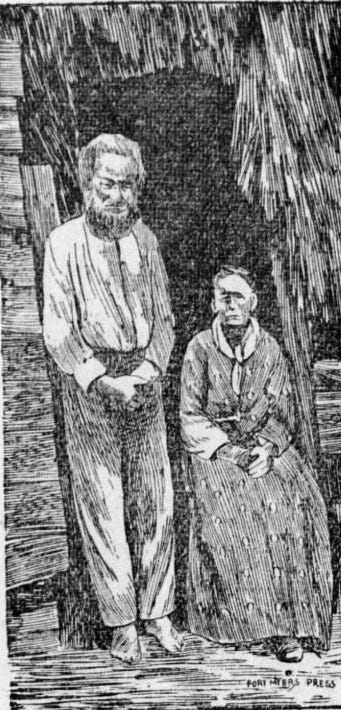Of all the pirates who probably never lived, José Gaspar, better known as Gasparilla, is the most famous. Although Gasparilla was said to have plundered and pillaged in waters in Charlotte and Lee counties, it was Tampa who embraced the mythical pirate as a source of civic pride, welcoming “Ye Mystic Krewe of Gasparilla” to the city for a festival in 1904 in a bid to increase tourism. The Tampa party is still going 120 years later, and the pirate’s lore touches some of our favorite Southwest Florida spots.
First, the legend. José Gaspar was said to have run off from a Spanish noble family, or maybe just from the Spanish Navy. He was ruthless, kidnapping women and keeping them captive on a nearby barrier island that came to be called Captiva. He fell in love with one of these women, a Princess Josefa of Spain, and killed her in a rage when she spurned him. He named another island Useppa, a mangling of her name, in her honor. His favorite island, and the base of his operations, he named after himself, naturally. He drowned himself in 1821, rather than allow his ship to be captured, and the treasure he left was never found.
As Karl Bickel points out in his book The Mangrove Coast, the above names are on maps of the area well before the rumored years that Gaspar sailed around the Gulf of Mexico. Gasparilla Island is almost certainly named after a Friar Gaspar, part of a doomed and deadly Jesuit mission to the area in the 1560s.
But sometime after 1904, the Charlotte and Northern Railroad printed The Story of Gasparilla, with all the elements of the legend rolled into it. The author claimed as his source the memories of a man known as “Panther Key John,” or Juan Gomez, who was said to have been both Gaspar’s brother-in-law and a member of his crew.
Juan Gomez and his wife moved to an otherwise uninhabited Panther Key, near Marco, in the 1870s. Gomez died in 1900. When he was alive, any past he had as a pirate was not what he chatted about to the Fort Myers Press and its correspondents. Instead, he liked to brandish a birth certificate that proved that he had been born in Europe in 1781, making him 119 years old at the time of his death. (Some accounts say he was 122.) He passed not from old age or ill health but drowned fishing for mullet.
(Juan Gomez and wife, from an 1896 issue of Fort Myers Press)
Following the trail
Born in 1896, Orlando “Jack” Beater was a successful Fort Myers business owner who started publishing historical and technical articles in his 30s. After he sold his business at age 50, Beater devoted much of his writing career to uncovering the facts about Gasparilla and documenting his legend. His book The Gasparilla Story, first published in 1952, was a straight biography, and The Sea Avenger, a blend of fact and fiction, was published in 1958. He died in 1969.
When he joined the staff of Fort Myers News-Press in the 1970s, Randy Wayne White, now a bestselling novelist, retraced many of Beater’s research steps. He corresponded at length with staff at National Archives, Office of Naval Records and Library, and came up with no evidence that there really was a Gaspar.
“So let us review the truths and the half-truths and the legends of lost treasure in Southwest Florida,” White wrote in the News-Press on March 23, 1975. “Every time I interview or speak with a longtime Southwest Florida resident I ask if they have ever heard of someone finding Spanish treasure. And unfailingly I hear a new story—or at the very least—a new twist on an old one.”
(An actor portrays Juan Gomez in a 2019 episode of Discovery’s Expedition Unknown. The show put the ongoing search for Gaspar’s loot on the national radar.)
But wait, Lee County did have a pirate!
Maybe not a pirate. It’s possible that Captain William Joselyn just liked having people be too scared to visit him. Probably from New England, he settled in the 1870s on what is now Josslyn Island, a now-protected Calusa-associated site in Pine Island Sound. We might not have any impression of him at all if not for Englishman F.T. Trench Townshend’s book Wild Life in Florida, with a Visit to Cuba, published in 1875.
Townshend and a fellow Brit meandered through the state, tormented by mosquitoes and sand flies, and ended up at Punta Rassa, where George Shulz ran the telegraph office and welcomed sailors, cattlemen, and hapless travelers. Townshend heard of Joselyn (a name he misspells as Jocelyn) while sailing through Pine Island Sound, as they passed the little key on which he lived:
“Professing to be an Englishman from Plymouth, he calls himself Captain Jocelyn, and some years ago settled down on this desolate island, nothing being known of his previous life. He built himself a house and a boat, and soon became the terror of the whole coast as a pirate and murderer. His plan was to invite any stranger he might hear of on the mainland to visit him in his island-home, and convey him thither in his own boat, when the unfortunate passenger would never again be heard of—Captain Jocelyn invariably saying that the boom of his main-sail had knocked the man overboard and drowned him…
“I had the honor of meeting this pirate of the Gulf a few days afterwards at the Telegraph station at Punta Rassa, where he landed in his little cutter, and a more cut-throat-looking desperado I never beheld. Apparently between forty-five and fifty-five years of age, of medium height, very strongly built, with long black hair and beard, and flashing black eyes shaded by heavy eyebrows, he was quite the beau-ideal of a pirate, and his dress and arms fully kept up the character.”
Townshend’s breathless writing notwithstanding, the desperado Joselyn sounds a little less than diabolical when you find out that he was there to bring Mrs. Shulz potatoes that he’d grown. Still, the Englishmen sailed off for Boca Ciaga swearing they’d just made it out with their lives.
(This could have been us! Vintage postcard illustration, c. 1950)










Although I will never clearly remember the event itself, I will never forget having once attended a Gasparilla celebration. Tampa’s Unofficial Motto: Any Excuse to Drink in Excess. Fantastic opening sentence—delicious!
Captain Jocelyn’s story is so fascinating. And Gasparilla’s is an iconic one. Hope you’re well this week, Tracy- 🙌🏼